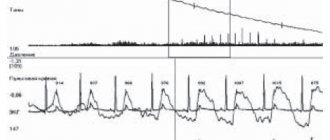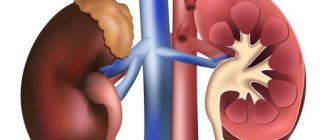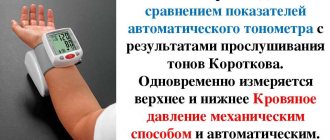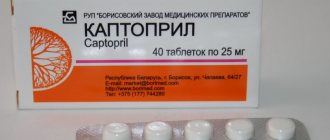29.09.2018
Last modified: August 18, 2021 at 05:25 pm
Blood pressure is one of the indicators of the proper functioning of the body, and any changes may indicate dysfunction of the cardiovascular system. A condition associated with short-term increases in blood pressure is called pressure lability, or labile hypertension. It is not directly life-threatening, but can cause serious complications. How does blood pressure lability manifest itself? Is it necessary to treat the disease?
What kind of pathology is this?
"Lability" means temporary or unstable. In fact, labile hypertension is short-term surges in blood pressure that occur due to spasms of small and large arteries. This leads to a decrease in their lumen, which increases the load on the walls.
The increase is usually insignificant, no more than 140/90, and both blood pressure indicators change at once or only systolic (isolated hypertension), while diastolic remains at a normal level. According to the international classification of diseases, ICD-10 is included in class I10-I15, and the code is determined depending on the causes and clinical course.
Labile hypertension has significant differences from the essential, or stable form of the disease. It is characterized by periodic increases in blood pressure, which decrease without the use of medications. In hypertension, the levels are constantly elevated, and return to normal only after taking antihypertensive medications. The stable form is more often characteristic of the elderly, and the unstable form can occur in young people, adolescents, and children. A labile increase in pressure may be the first stage of essential hypertension.
Attention! Essential hypertension and labile hypertension have similar symptoms, but the clinical course and treatment methods are different.
Symptoms
Emotional instability with lability of blood pressure
With sharp increases in blood pressure in patients, the following conditions are typical:
- a headache suddenly begins to ache, often in the forehead or back of the head;
- irritability increases and emotions become unstable;
- memory deteriorates, attentiveness and learning ability decrease;
- sleep is disturbed, difficulty falling asleep;
- “flies” or “rainbows” flash before the eyes;
- limbs go numb and burn.
In people: young or old, the quality of life decreases with a steady progression of such symptoms.
Phases of the disease
A labile increase in pressure is the result of a violation of the mechanisms of nervous and hormonal regulation of the cardiovascular system. The clinical course of the disease is characterized by two phases:
- at the first stage, blood pressure increases only under the influence of external factors - when the temperature changes (extreme cold or heat) or after nervous strain;
- during the second, or transient stage, the indicators increase to a greater extent, and jumps occur regularly, sometimes at rest, but return to normal without the use of medications.
The increase in blood pressure numbers at the first stage lasts no more than 20 minutes, then they normalize along with the state of health. Hypertension cannot be ignored even in cases where the person’s condition does not worsen. Any pressure surges negatively affect the functioning of the entire body. If the first stage of the disease is left untreated, it can quickly progress to the second and lead to serious disruptions in the functioning of internal organs.
Features of the course of the disease
Labile hypertension develops progressively; doctors describe 3 stages of the disease:
- Initially, based on the symptoms that patients describe, it is quite difficult to establish an accurate diagnosis, since obvious abnormalities are not detected. The main symptom at this stage is associated not with a physiological, but with a mental state - patients often complain of nervous tension and sleep disorders.
- At the second stage, there are also no clearly defined health complaints, but an increased level of pressure is recorded instrumentally, which can be described as moderate hypertension. Some patients are characterized by periodically occurring hypertensive crises and renal dysfunction. However, a routine urine test gives normal results.
- Symptoms of the disease are pronounced, and patients often experience discomfort due to pressure surges. At this stage, the preconditions for myocardial infarction often develop, so it is quite dangerous to start the disease.
The rate of development of pathology is not the same; it largely depends on the individual characteristics of a person, his lifestyle and chronic diseases.
Reasons for the development of pressure lability
The exact prerequisites are unknown, but there are factors that contribute to disorders of the cardiovascular system:
- excess weight and lack of physical activity, leading to increased cholesterol in the blood and difficulty in blood circulation in the vessels;
- frequent consumption of drinks that stimulate the nervous system - coffee, strong tea, energy drinks;
- excessive amount of salt in the diet, which provokes fluid retention and disruption of blood pressure regulation;
- endocrine pathologies, including diabetes mellitus;
- regular stress, nervous tension;
- smoking, alcohol abuse, which causes vasospasm - first temporary, then permanent;
- vegetative-vascular dystonia (VSD);
- hereditary predisposition to disorders of the cardiovascular system.
Important information: Does a copper bracelet help with blood pressure?
In addition, there are physiological causes of labile hypertension. The pathology is observed in adolescents during the period of hormonal changes, in women during pregnancy or menopause along with hot flashes, as well as in people who engage in strenuous mental or physical labor.
If the difference in indicators is no more than 10 mm Hg. Art., quickly returns to normal and does not worsen the quality of life, drug treatment is not required. Jumps in blood pressure that are observed in a child or a pregnant woman require constant medical supervision and monitoring of the condition to prevent complications.
For reference! For young people of military age, labile hypertension may provide a deferment or exemption from the army. An accurate assessment of the state of health and a decision on the impossibility of military service can only be given by a medical commission.
Diagnostics
Diagnosis for suspected labile blood pressure should be multifaceted:
- examination and history taking - the doctor will listen to the patient and tap his chest, and also measure his blood pressure right in the office;
- general urine and blood tests, as well as a biochemical urine test, will allow you to get an idea of the general condition of the body, whether all organs are working normally;
- ECG - will allow you to get an idea of the state of the heart;
- Ultrasound - allows you to look at the condition of internal organs;
- Scanning of blood vessels will show that their condition leaves much to be desired.
But the main method remains daily blood pressure monitoring - the patient is assigned a time at which he should measure his blood pressure and is given a form for recording. As a result of more than twenty measurements per day, the doctor can get an idea of the state of the patient’s blood pressure.
Symptoms of the disease
A feature of labile hypertension is its mild symptoms, which often complicates the diagnosis and treatment of the disease. Symptoms include:
- headaches, usually in the back of the head or temples;
- nervous disorders - tearfulness, moodiness, causeless mood swings;
- increased heart rate;
- sense of anxiety;
- dyspnea;
- facial redness;
- insomnia or, conversely, constant drowsiness and fatigue;
- impaired concentration and memory;
- numbness of the arms and legs, coldness in the extremities.
Such manifestations do not always mean problems with dysfunction of the cardiovascular system, so fluctuations in blood pressure can only be determined using a tonometer.
Emergency help at home
With a slight increase in blood pressure, the condition can be alleviated without taking medications. First of all, you need to lie down or sit in a comfortable position, relaxing (sometimes a short rest gives good results), or use one of the simple remedies:
| Massaging the collar area and head for 10-15 minutes improves blood circulation, relieves headaches, and returns blood pressure to normal. |
| Hand baths quickly remove the manifestations of labile hypertension - you need to take hot water into a suitable container and hold your hands in it for 10 minutes. |
| You can apply pieces of cloth soaked in apple cider vinegar to your feet (the procedure lasts 10-15 minutes). |
| Dissolve a teaspoon of honey in a glass of water (it is best to use non-carbonated mineral water), squeeze in the juice of half a lemon, and drink at once. |
If traditional methods do not produce an effect, you need to switch to taking medications. It is best to drink a natural-based sedative (tincture of valerian, motherwort or peony, Persen), and if the condition does not improve, use antihypertensive drugs. Tablets should be taken with caution, not forgetting the contraindications and side effects that are prescribed in the instructions for use.
Important information: Lifestyle with hypertension: basic rules
Attacks of labile hypertension are often attributed to ordinary fatigue, which is why the disease is diagnosed late. If symptoms are observed regularly, you should urgently consult a doctor, otherwise the pathology can provoke serious complications.
Medicines
If labile blood pressure is a symptom of hypertension, endocrine and other pathologies, then the doctor prescribes medications individually according to the symptoms.
Remedies for high heart pressure
For arterial hypertension and hypertension, drugs from the sartan group are effective due to their high therapeutic effect.
Hypertension drugs
For example, for hypertension, treatment is prescribed:
- Losartan, Valsartan, Cardosal, Candesartan, Eprosartan - as angiotensin receptor blockers or sartans;
- Artesin, Doxazosin, Terazosin, Proxodolol, Urorek - α-adrenergic blockers;
- Zocardis, Kizinopril, Captopril, Prestarium - ACE inhibitors (angiotensin-converting enzyme);
- Veroshpiron, Indapamide, Torasemide, Furosemide - diuretics (diuretics);
- Amlodipine, Verapamil, Diltiazem - calcium antagonists.
Treatment
In the initial stages, therapy for labile hypertension is based on lifestyle correction and elimination of factors that contribute to vascular dysfunction. To do this you need:
- to refuse from bad habits;
- increase physical activity - play sports, walk in the fresh air more often;
- eat right, avoid fatty, fried, salty foods (salt intake should be reduced to 2 grams per day), include lean meat, fish, fresh vegetables, fruits, vegetable oils, nuts in the menu;
- observe a daily routine - sleep at least 8 hours a day, and going to bed should be no later than 10-11 pm;
- reduce consumption of strong tea, coffee, energy drinks;
- reduce the amount of stress, learn to behave correctly in critical situations - you can reduce stress with the help of breathing exercises, yoga, psychotherapy;
- to calm the nervous system, use natural-based drugs - Novopassit, Persen, Sedavit, as well as infusions and decoctions of medicinal herbs with a sedative and restorative effect.
If the pressure rises to 160/100 mm Hg. Art. and above, the patient needs complex treatment using medications that eliminate the causes of lability and contribute to the restoration of the body.
Prevention
To prevent labile hypertension, it is necessary to exclude all factors contributing to the pathological process. To prevent disorders of the cardiovascular system, it is necessary to lead a healthy lifestyle, exercise, give up bad habits and devote time not only to work, but also to proper rest.
Once a year, it is recommended to conduct a preventive examination with a cardiologist and do a cardiogram. This will help avoid pathologies and serious complications such as heart attacks and strokes.
Labile hypertension does not pose a direct threat to life, but over a long period of time it can develop into a stable form and provoke irreversible disturbances in the functioning of the body. Seeing a doctor in a timely manner and following all his recommendations will help you maintain health and activity for many years.









